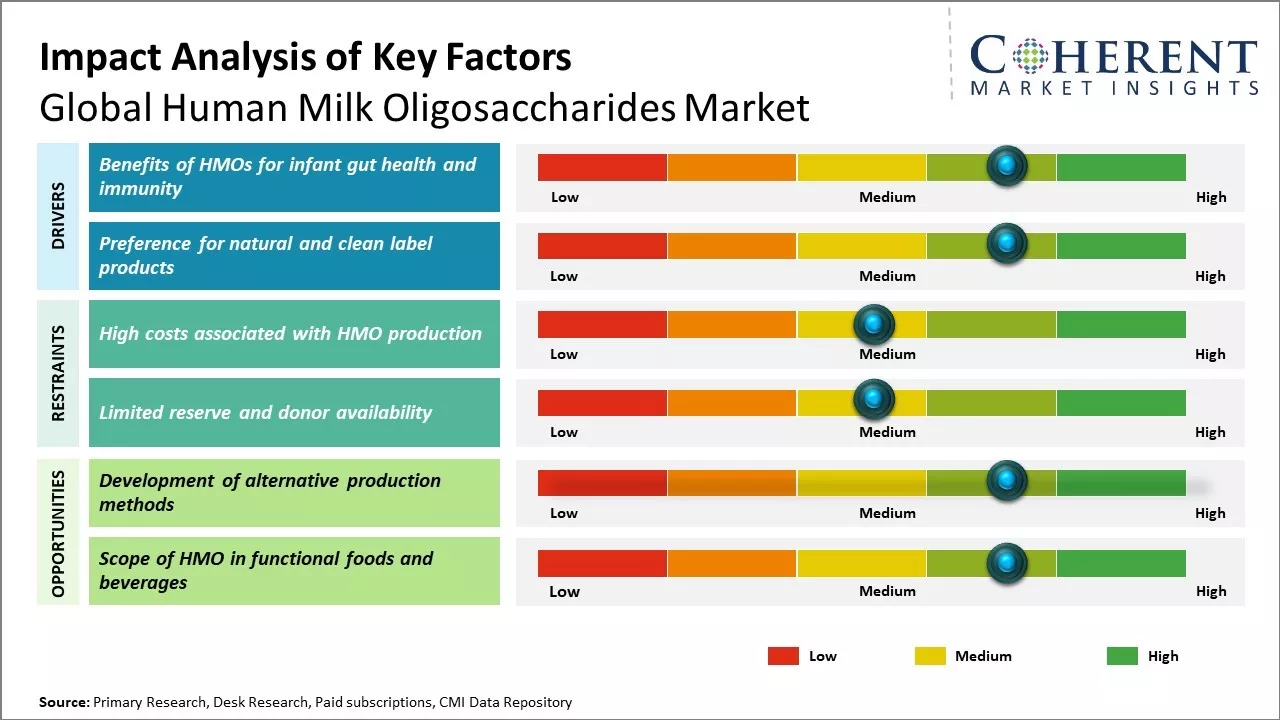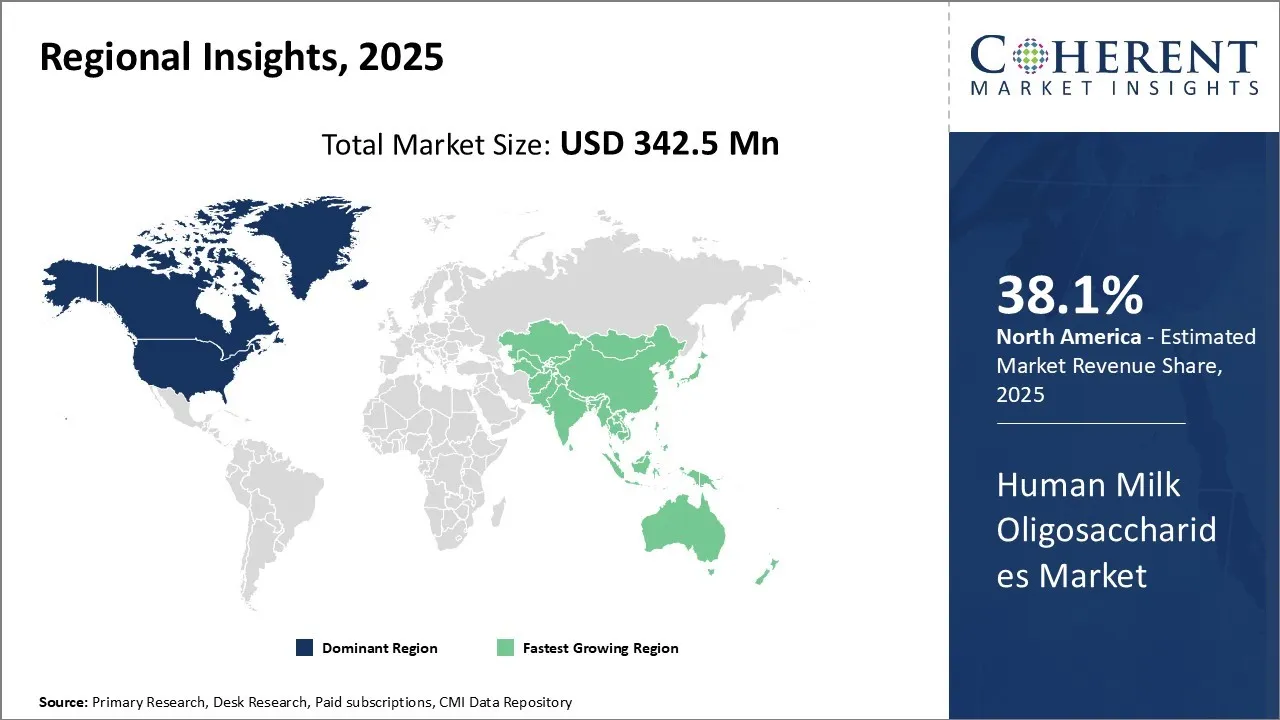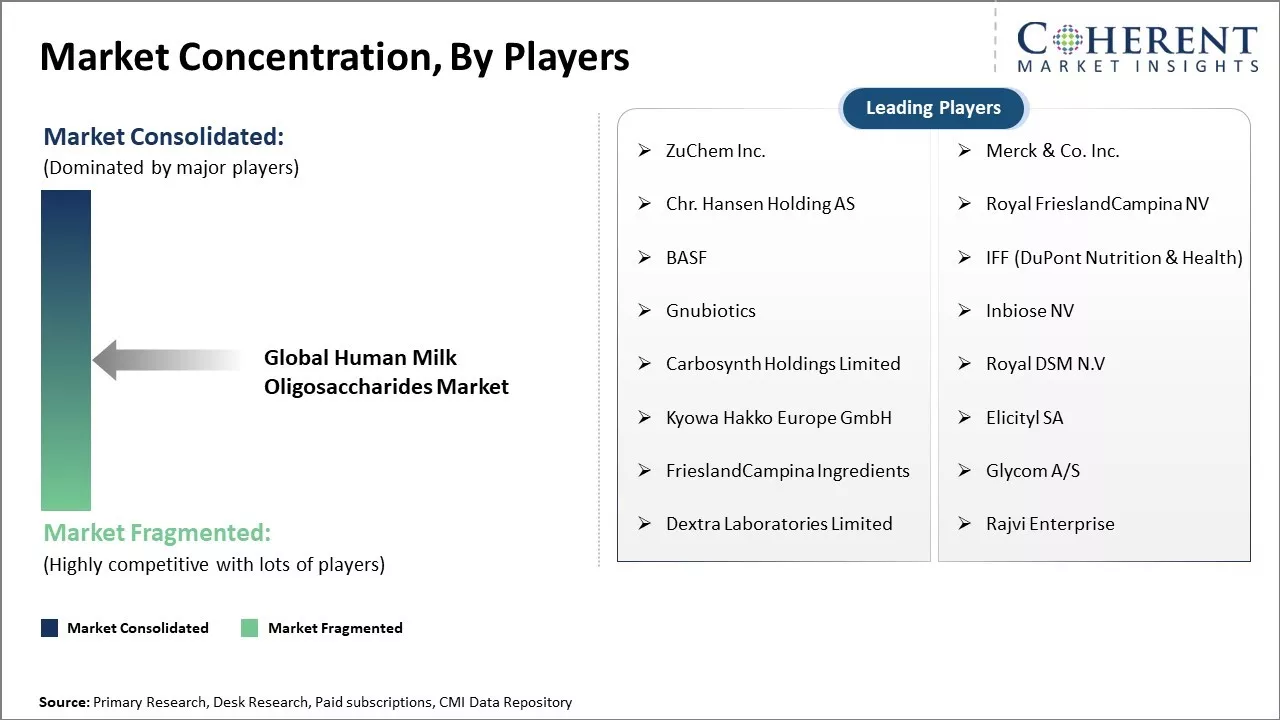The human milk oligosaccharides market is estimated to be valued at USD 342.5 Mn in 2025 and is expected to reach USD 895.2 Mn by 2032, exhibiting a compound annual growth rate (CAGR) of 14.7% from 2025 to 2032.

To learn more about this report, Download Free Sample
Rising awareness about the health benefits of human milk oligosaccharides (HMOs) for infant nutrition is driving the growth of the market. HMOs play an important role in boosting immune health, gut health, and brain development. They act as prebiotics that promote the growth of beneficial microbes in the intestines. With rising rate of working women population, the demand for formula-fed babies is increasing globally. Manufacturers are focusing on fortifying infant formulas with HMOs to provide functional benefits similar to breast milk. The emerging applications of HMOs in food & beverages, pharmaceutical, and personal care products is expected to open new growth opportunities for the market in the coming years.
|
Current Events |
Description and its impact |
|
Geopolitical and Regulatory Trends |
|
|
Economic and Digital Infrastructure Trends |
|
|
Technology Trends and Enterprise Demands |
|
Uncover macros and micros vetted on 75+ parameters: Get instant access to report
In terms of application, the Infant formula segment accounts for a 55.1% share of the human milk oligosaccharides market in 2025, owing to increasing focus on baby nutrition. Breastfeeding is considered the gold standard for infant nutrition; however, many mothers are unable to breastfeed due to various reasons. This has resulted in a rise in the demand for infant formula that can provide nutrition as close to breastmilk as possible. Major infant formula manufacturers are actively working to enhance the nutritional profile of their products. They are investing heavily in research and development activities to identify and add various important human milk oligosaccharides found in breastmilk into formula.
For instance, in June 2025, Nestlé has launched Gerber PRO rice cereal enriched with the human milk oligosaccharide 2'-fucosyllactose (2'-FL) in China. Approved by the National Health Commission for use in infant complementary foods, the product also includes protein and probiotic Bifidobacterium lactis BB-12 to support immunity, as Gerber expands its infant-formula-inspired nutrition range.
In terms of type, the 2’FL segment is expected to account for 29.2% share in 2025. It is one of the most abundant and widely studied oligosaccharides found in human breast milk. Extensive research has identified 2’FL as a prebiotic that supports the growth of beneficial gut bacteria in infants. Due to its versatile functional properties and supportive clinical research, 2’FL finds wide applications across various end-use segments. It is extensively used in infant formula to enhance the prebiotic profile. Several global formula brands have incorporated 2’FL into their “next generation” formulas marketed with added health benefits. 2’FL is also utilized in dietary supplements targeted for gut and immune health.
For instance, in May 2025, BENEO, a key supplier of functional food and pharma ingredients, and biotechnology specialist WACKER have teamed up to introduce the human milk oligosaccharide 2’-Fucosyllactose (2’-FL) globally. Produced via precision fermentation in Europe and commercialized by BENEO, this launch boosts HMO supply for infant nutrition manufacturers.

To learn more about this report, Download Free Sample
North America continues to dominate the global human milk oligosaccharides market, primarily led by the U.S. The region is expected to account for 38.1% of the market share in 2025. The region has a strong foothold of major players that are continuously investing in clinical research and product development activities. Numerous clinical studies validating the health benefits of HMOs have created widespread awareness among consumers in the region. This has boosted the incorporation of HMOs into infant formula, pediatric nutrition, and other pediatric healthcare products. Moreover, the growth of the nutritional and dietary supplement industry has widened the application scope of HMOs.
In August 2024, DSM‑Firmenich AG achieved a significant regulatory milestone: it obtained U.S. and Australian approval for its GlyCare 3‑Fucosyllactose (3‑FL) ingredient, eligible for incorporation into functional foods and dietary supplements. This approval substantially broadens HMO applications beyond traditional infant formula into the wider health and wellness sector.
Asia Pacific is identified as the fastest growing regional market. China represents a highly lucrative market driven by improving living standards, rising health consciousness, and an expanding consumer base. There is a growing interest among Chinese manufacturers to develop advanced pediatric nutrition products. This has prompted them to form partnerships with global leaders for technology transfers. Additionally, several rural and underdeveloped parts of the country still face problems of malnutrition and infant mortality. This has fostered government support through rural healthcare projects involving HMOs. Japan is also a major domestic market characterized by an aging population and increasing preference for preventive healthcare solutions.
In March 2024, Wyeth Nutrition introduced China’s first infant formula featuring a dual-HMO formulation. This product incorporates 2’-Fucosyllactose (2’-FL) and Lacto‑N‑neotetraose (LNnT), a combination not previously commercialized within the Chinese market.
The U.S. leads the global HMO market due to its advanced biotechnology sector, strong regulatory framework, and widespread consumer awareness of infant health benefits. Major players like DSM–Firmenich, DuPont, and Infinant Health continue to invest heavily in clinical trials and fermentation-based HMO production. Robust demand for HMO-enriched infant formula and dietary supplements supports the country’s dominant market share.
For instance, Abbott continues to refine its infant formula by integrating human milk oligosaccharides (HMOs), including being the first U.S. company to introduce 2'-FL HMO. The latest Similac 360 Total Care formulas feature a five-HMO blend, boosting growth, gut health, immunity, and brain development and solidifying the company’s scientific leadership.
Germany is a key hub in Europe for HMO research and production, backed by its pharmaceutical and functional food industries. The country’s strict quality standards and demand for scientifically supported infant nutrition products drive adoption. Companies like Jennewein Biotechnologie (now part of Chr. Hansen) have positioned Germany as a center for HMO innovation and export.
For instance, in June 2025, A new preclinical study by Pudenz et al., conducted with ETH Zurich, reveals that blending chicory-derived inulin-type fructans with the human milk oligosaccharide 2’-fucosyllactose (2’-FL) produces synergistic effects on toddler gut microbiota. The combination enhanced butyrate production and beneficial bacteria growth, surpassing individual effects, supporting the case for prebiotic blend use in early-life nutrition.

To learn more about this report, Download Free Sample
| Report Coverage | Details | ||
|---|---|---|---|
| Base Year: | 2024 | Market Size in 2025: | USD 342.5 Mn |
| Historical Data for: | 2020 To 2024 | Forecast Period: | 2025 To 2032 |
| Forecast Period 2025 to 2032 CAGR: | 14.7% | 2032 Value Projection: | USD 895.2 Mn |
| Geographies covered: |
|
||
| Segments covered: |
|
||
| Companies covered: |
ZuChem Inc., Merck & Co. Inc., Chr. Hansen Holding AS, Royal FrieslandCampina NV, BASF, IFF (DuPont Nutrition & Health), Gnubiotics, Inbiose NV, Carbosynth Holdings Limited, Royal DSM N.V, Kyowa Hakko Europe GmbH, Elicityl SA, FrieslandCampina Ingredients, Glycom A/S, Dextra Laboratories Limited, and Rajvi Enterprise |
||
| Growth Drivers: |
|
||
| Restraints & Challenges: |
|
||
Uncover macros and micros vetted on 75+ parameters: Get instant access to report
Scientific research increasingly highlights the benefits of human milk oligosaccharides (HMOs) for infant health. HMOs, the third largest solid component of breast milk after fat and lactose, act as prebiotics that feed beneficial gut bacteria like Bifidobacterium, supporting gut microbiota development and strengthening immune function. They reduce the risk of infections, diarrhea, and respiratory illnesses in infants. With declining global breastfeeding rates, HMO-fortified formulas are gaining attention to provide similar immune and nutritional benefits. This trend is driving human milk oligosaccharides market demand, with manufacturers focusing on cost-effective production methods to include specific HMOs in infant nutrition products.
Along with health considerations, changing consumer preferences are shaping industry trends in the human milk oligosaccharides market share. There is rising global demand for natural, organic, and clean-label products, as parents increasingly seek options free from artificial colors, flavors, and preservatives. In this context, HMOs offer clear advantages over synthetic additives in infant formulas and foods. Being naturally occurring components of breast milk, they resonate with health-conscious consumers who prefer formulations with simple, easy-to-understand labels, further driving the market’s growth and adoption worldwide.
The development of alternative production methods could unlock significant opportunities in the human milk oligosaccharides market forecast. Traditionally, HMOs are harvested from human breast milk in limited quantities, restricting their availability and applications. Emerging biosynthetic and fermentation technologies now enable scalable, reliable production of HMOs outside the human body. This evolving production landscape is expected to accelerate innovation and expand adoption of HMOs across infant nutrition, pharmaceuticals, and functional food industries over the coming years.
*Definition: The human milk oligosaccharides market consists of innovative nutritional supplements based on the complex sugar molecules found naturally in breast milk. These unique oligosaccharides serve important prebiotic functions that support immune and brain development in infants. As researchers advance understanding of their health benefits, companies are developing purified human milk oligosaccharide supplements to replicate these important benefits for formula-fed babies and other vulnerable groups. The growing human milk oligosaccharides market offers promising functional ingredients for pediatric nutrition and beyond.
Share
Share
About Author
Sakshi Suryawanshi is a Research Consultant with 6 years of extensive experience in market research and consulting. She is proficient in market estimation, competitive analysis, and patent analysis. Sakshi excels in identifying market trends and evaluating competitive landscapes to provide actionable insights that drive strategic decision-making. Her expertise helps businesses navigate complex market dynamics and achieve their objectives effectively.
Missing comfort of reading report in your local language? Find your preferred language :
Transform your Strategy with Exclusive Trending Reports :
Frequently Asked Questions
Joining thousands of companies around the world committed to making the Excellent Business Solutions.
View All Our Clients